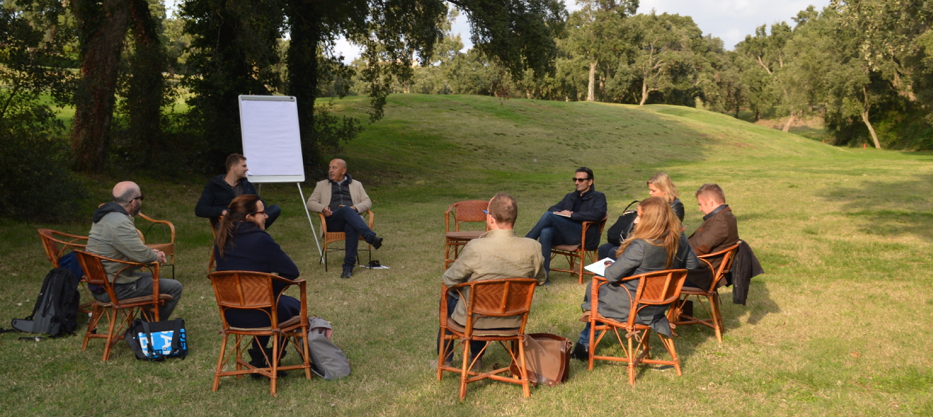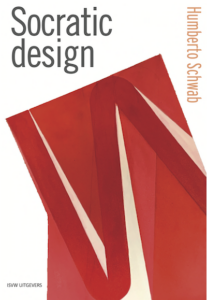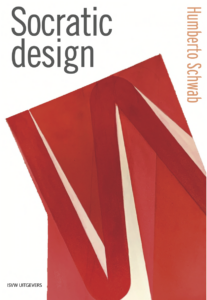The fallacies in our system of thoughts and feelings
On Dialogue

This article is a reflection on one of the philosophical pillars of the Socratic Design method, the book On dialogue of David Bohm.
Recently I (Humberto Schwab) had the honor to write the preface for the Dutch translation of the book. Which made me realize the importance of this book ones again.
It presents us with an answer on how to change and solve problems worldwide. It shows us how we made wrong interpretations about our “inner” and “outer” experience, and about the self in general. It shows us how we use an incorrect view of thinking and feeling, and the devastating effects of that, on ourselves, on our society and the planet.
A man Like David Bohm who earned so many credentials in the field of science, by thinking about quantum physics and physics, qualifies our definition of science as erroneous.
This book offers a way to change things individually and collectively; it may change your life, and present a hint on how we can cope with some of our current collective challenges.
A system relying on dopamine
How is it possible that we make such a wrong interpretation of what and who we are and how we operate and continue living in this fallacy for thousands of years?
The answer is simple; our lizard brain is adapted to function in the harsh circumstances of the desert, the steppe or the savanna. It is the oldest part of the brain which we call the mid-brain stem or the lizard brain. This part of the brain regulates the hormones for our most primal responses, hunger, reproduction, fear, attack, flight, etc. We can say that this is the foundational system that operates in our mind and body system. A simple example is the continuity of our sexual desire in our existence. Since ages engrained in our organisms.
Endorphins steer the reflexes, actions, and reactions of our body system and they work in our nerve and hormone system.You get a feeling of pleasure when dopamine connects to one of the four receptors, and you feel content or happy when serotonin binds to one of the 14 receptors in the neocortex.
The dopamine works mainly in the lizard brain, the serotonin in the younger prefrontal cortex.Dopamine is the instant drug, associated with short-term pleasure and always asking for more of the same. Serotonin is associated with contentment, real happiness and does not need more. It is a feeling of fulfillment.

It is the dopamine system that has been stimulated by our consumer culture of the past decades. Dopamine has two significant characteristics; it connects to stimuli outside us, and it always craves for more. We have built our whole economy on easy, instant satisfaction: sugar, drugs, liquor, sex, porno, medicine, and recently social media.
We can say that religion in many examples has functioned to limit the effects of this dopamine circle or to tame the addictive beast in us.
Religion functioned to constrain our addictive behavior and constrain our lust. But, we all know examples of sexual abuse within protestant families and Catholic churches. So, we can say that religion was controlling our dopamine system, but, even in the context of faith, our lizard brain was able to take control of us. Nevertheless, we should ask the question; does it make sense to limit our dopamine dependence and how to do this?
In some postmodern societies, we tried to eradicate all restrains on our lusts and desires. It produced disoriented people living in a continuous state of addiction. In these situations, we have ultimately accepted that the dopamines run our whole system.
On the others side of the coin, we have the endorphin serotonin.
This neurotransmitter mainly connects to receptors in the front part of the brain, the neocortex. This part of the brain is responsible for complex activities like cooking, mathematics, playing piano, philosophizing, making a painting, storytelling, etc. It is not connecting to outside stimuli, but too subtle internal activities. The trait of the serotonin production is that you are satisfied with the circumstances as they are, it is called happiness or contentment. Everyone can have a sexual relationship running on dopamines, but one based on love is a much more long-term oriented process and more connected to the serotonin system.
But, even processes that mainly go on in the neocortex, where most of the serotonin receptors are situated, and which is our most reflective part of the brain, are directly connected to our midbrain stem. Also on this level of complexity, we can have old fight or flight reflexes, related to the tiger that used to threaten us. When somebody tells you that you are a racist, you can get aggressive about it because of this connection with the lizard brain. Or when you work on a painting, you can get frustrated because what you want to create seems to be impossible.
In these cases, the lizard brain takes over. Its context is no longer the hunting grounds of the savanna; now the reptilian brain has the complex environment of our “thinking” or neo-cortex as it’s context. Dopamine releases and fight or flight reflexes connect to the complex activities of our neo-cortex. So abstract thoughts can also provoke instinctive primitive reactions. That is why we cannot think without our body.
So, when people think that they think, they are NOT. Mostly they are repeating thoughts. When you rehearse these thoughts, it will give you a nice feeling, because of the endorphin release connected to it.
When someone believes that “man is an egoist,” he will get a dopamine release each time he utters this. When you believe that your country is the best be it Catalan, German or French, you lock yourself in an addictive thought.
Now we can understand better collective derailments like fascism, racism, sexism, nationalism, but also the everyday stupidity of any scale that is stubborn and perseverant. The neuroscientific explanation of the connection between the brainstem and the neocortex gives us an in-depth view of the system of addictive thoughts. Besides our desire for sex, our hunger for meat, and our unstoppable social media addiction, our complex reasoning is also connected to the dopamine releases, specific thoughts can, therefore, be as addictive as smoking.
We call these addictive thoughts that repeat themselves; assumptions and these assumptions or necessities can be impossible to get rid off. They are simple or complex thoughts that are kept in place thanks to our dopamine system. You can see that in a comfort culture dominated by the short-term dopamine satisfaction, simplified, addictive, superficial thoughts have an accessible entrance.
Real happiness does not connect to outside stimuli. It is inside you, it comes without a cost, and we can´t make an economy about that. Probably that is the reason why we have this dopamine driven consumption culture, it works so well, effectively and efficiently. The increase of heroin victims in middle-class regions in the USA, bring to light the perverse character of our consumer’s culture.
Serotonin is happiness and dopamine is the pleasure. For the big audience, the meanings of these two words are entirely interchangeable; thanks to the advertisements of the consumer industry. Pleasure is happiness and happiness is pleasure. With this deliberate confusion of the mass, the profits of the happiness industry skyrocket. Sugar and diet industry is an example of this “dopamania”. In the American culture, the right to “the pursuit of happiness” formulated by Jefferson, has been mutated to the right on instant pleasure!
We can say that people have been set up to become dopamine-dependent, a perfect preparation to become a victim of easy concepts like comfort, fast food, and also nationalism in populist or right-wing movements. The addiction is in the system.
But there is an extra complication. High levels of dopamine block the release and transport of serotonin. So, more dopamine means no serotonin, and this prevents our experience of contentment or happiness. As long as we are stuck in addicting patterns, we can’t be content, and we will never be happy. It explains why depressive adolescents can cure by cutting out Facebook and Instagram.
A build-up of necessities
How is it possible that we continue this complete failure to recognize who we are?
In our lives we make assumptions, and some of them start from traumatic experiences. For example, your teacher in primary school told you that you are stupid. It hits you hard, and you believe him. Here is the beginning of an assumption. Now you think you are dumb because the teacher said so. You build a defense tower to protect yourself and hide your stupidity from others. You will also cover up this traumatic event for yourself, so you are not aware of the force in you.
You will not talk about intelligent things; you will avoid demanding games and high-level studies because you are afraid people will find out about your stupidity. The incident with the teacher becomes determining for you. Why can this incident have such an impact? Because it connects to childish pain, and pain can provoke a powerful addiction. Every time the assumption repeats itself in you, by yourself or by somebody else; you feel the pain accompanied by a release of endorphins. The more often you rehearse the thought, the stronger the necessity ingrains in your system. “When you fire, you wire!”
When a person has a traumatic experience of domestic violence in his or her youth, the assumption that men are cruel can easily take root. From then on the anxiety – that this intuition accompanies – will repeat itself in the observation of many other men. This assumption becomes an addiction rooted in the thinking of this person, the more the thought repeats itself in the perception, the stronger it gets.

David Bohm describes in the book Thought as a System, how thoughts and feelings are part of the same system that links inevitably to our dopamine reward center. Feelings are in that sense not different from thoughts. You ones felt it, it repeats itself, and you think you “feel” it again. Over and over again.
So, when somebody says: “I feel this,” therefore, it must be true, he or she is probably not feeling at all, but rehearsing a “felt” once experienced. To know what you think or feel you have to do something rigorous, and that is; observe yourself by you. Discover and analyze what your deep underlying assumptions are. The strongest ones are called necessities by David Bohm. These are the ones when you use the phrase ” I always say….”.
They act like reflexes. These necessities can be positive or negative. For example; teachers always think that they have to know what pupils have to think about the questions the teacher poses. The teacher has the necessity that he/she has to guide the soul of the child.
Necessities are not just rooted in your personal experiences; also cultures contain a lot of unreflected necessities.
In some protestant cultures, guilt is a deep-rooted necessity. This feeling of guilt can guide you permanently and unconsciously! In Mediterranean cultures, the family is one of the most important necessities. In the USA private property is the strongest one in political reasoning.
Cultures install many necessities in us without us being aware.
The word necessity stems from “no cesare” which means don’t yield, don’t give in. When people enter into a Socratic Design program, we open up a whole culture by looking at the necessities of just one person. The “ecology of meaning” of an entire culture demonstrates itself in one person. When we can change it in one person, it implies we can change it in many others so that we can change the whole ecology. That is very powerful and hopeful.
Seek and destroy viral thinking
On our own we are utterly forceless against our necessities; we need force and strength of others to be able to see them. When you go into a disciplined dialogue, you have the power of the group that enables you to see them. You sit down with each other, and together you observe the process of thinking that is going on. All the blockages and necessities will come to the surface, and you can look at them thanks to the “collective attention”. In such dialogue we slow down the tempo, we don’t discuss, and together we form a sort of mini-culture. We practice the art of listening. Why is this collective process essential? Because the culture created our collective meanings and these we can transform by way of a collective effort. On our own, we are doomed to rehearse our necessities over and over again without noticing. The center of the thinking activity is not in our “brain;” it happens in-between people.

This insight is in drastic disagreement with the model of the rational stand alone, who places the center of the thinking in our private mind. But, in dialogue, we can see the thinking taking place in-between us, in our collaborative attention and in our collective awareness. A key word here is attention, only by directing this attention we can find out what blocks us or what is active in us as a necessity.
Also by carefully observing your self you can know when a feeling or thinking is authentic or just a rehearsal of thoughts and felts. You can feel the aggression towards for example a teacher, a friend, or a president, then, observe yourself and see what is happening to me? Why is this happening inside me? And why am I “doing” this? Observe thinking and feeling like something that is a material virus, not as something that you initiate. Not as something that is you. We make the mistake that there is something been thought or felt in our mind, so there must be a “somebody” that does the thinking and the feeling and that somebody must be me!
We mistakenly think that we are observing, so there must be somebody observing. From that, we then conclude that there must be an identity that is observing, thinking, and feeling. But there are just thoughts and feelings circulating in your embodied mind by themselves, like viruses. They enforce themselves, and you are merely the platform. That is why David Bohm says that thinking is material.
Collectively or individually we can learn to seek and destroy viral thinking and feeling processes. We have to be attentive. Do I want to think this? Do I want to feel this? Why do I feel this? Why do I think this? Where do I feel this? Do I want to act upon it? Do I want to observe this? Only by focussing our attention we can we kill this viral process. And the dialogue is a powerful way of doing that collectively.
In a typical discussion, we all follow our own line of reasoning, and that makes it impossible to listen to the others. Only in a disciplined dialogue (like specific practices of the Socratic Dialogue where we are forced to listen to one and other) we can join our attention and our consciousness. When participants are forced to listen to one-an-other their tacit assumptions are growing together. It is this uniting of the “tacit ground” of our being that is the secret to the creation of new insights and the incubating of new thoughts.
So, the reality is not something we have to look for externally. Reality may come up out of this tacit ground, thanks to our participating awareness. We participate in truth because, it is many more than just words, truth arises out of the tacit common ground. The truth is something we can not talk about like Ludwig Wittgenstein famously said, it will “show” itself.
So, this model offers us hints how to eliminate addictive assumptions about yourself, the culture, or even how to stop worldwide addictions. How? Practice disciplined Socratic dialogue, experience the attentive awareness and exercise the highest level of the “neocortex consciousness.”
Getting out of our imprisonment
The switch from short-term “dopamine” to long-term “serotonin” awareness is a big political challenge. Participating in collective attention with a long-term “serotonin” focus is in itself a political deed. John Dewey defined precisely that as a democracy.
John Dewey; “Democracy is when people are in charge of the culture that is creating them.”
In other words, democracy is when people can determine the necessities that determine them.
We have to understand that we always will have necessities because that is how our embodied-mind system works. But, we have to choose them carefully and create them critically. For instance, we can replace the idea that humans are egoists for the assumption that humans are empathic. And then build different houses, cities, cars and so on.
Why do we maintain in ignorance? Because lots of our necessities are connected to fear and trauma, they shield them away and at the same time tie us to these sensations. When you want to become aware of your assumptions it often implies facing your strong fears.
Facing your anxiety and fear is the starting point towards coherence. Many assumptions root in entirely wrong systems of meaning.
David Bohm shows us that we most of the times observe our assumptions. It seems like you are observing the world, and then you say; these are the facts, and this is the conclusion. Wrong! You look at your assumptions. When you think a certain group of persons are criminal, you will see the criminality in all the observations of these persons. When you believe that women can’t drive, you look at them, and you see always confirmed that indeed they can’t. You look at your assumptions, David Bohm calls this your “screen of thoughts.”
The past-experience is present in the moment now and here. This phenomenon is called re-presentation. Re-present is a beautiful English word that manifests that we are not present. We are always “re-present.” We unintentionally rehearse terrible traumas, necessities, thoughts, feelings, etc. We are addicted to this circle. Even fear is addictive because evolutionary it was a big help.
So, here we have the major challenge for any person, but also for any organization, political party, science, media, education, etc. Get out of the imprisonment of blocking necessities, which have led us to our ecological, geographical, political crisis. Detect the destructive assumptions at work and try to explain their genesis.
Stop thinking
What most people are doing to overcome their problems is to THINK more. They engage in to think thanks and brainstorms to overcome their challenges, but, what they do not realize is that they keep re-producing the same problems with the same modes of thinking. Thinking is not the solution it is the root of our problems.
People are not aware that thinking is something that is actively creating the world and then says; I did not do that, I am just looking at the world. So, thinking is a material intervention. When it acts on the wrong necessities, the consequences are fatal.
The solution or the opening is clear:
Stop repeating thoughts, observe what is going on when we think that we “think.” Observe yourself, focus your attention on the presence. Do it with collective attention. Focus it on what is going on in society, and then you will find out.


